Geoscience Frontiers ( IF 8.9 ) Pub Date : 2020-11-24 , DOI: 10.1016/j.gsf.2020.10.007 Himan Shahabi , Ataollah Shirzadi , Somayeh Ronoud , Shahrokh Asadi , Binh Thai Pham , Fatemeh Mansouripour , Marten Geertsema , John J. Clague , Dieu Tien Bui

|
Flash floods are responsible for loss of life and considerable property damage in many countries. Flood susceptibility maps contribute to flood risk reduction in areas that are prone to this hazard if appropriately used by land-use planners and emergency managers. The main objective of this study is to prepare an accurate flood susceptibility map for the Haraz watershed in Iran using a novel modeling approach (DBPGA) based on Deep Belief Network (DBN) with Back Propagation (BP) algorithm optimized by the Genetic Algorithm (GA). For this task, a database comprising ten conditioning factors and 194 flood locations was created using the One-R Attribute Evaluation (ORAE) technique. Various well-known machine learning and optimization algorithms were used as benchmarks to compare the prediction accuracy of the proposed model. Statistical metrics include sensitivity, specificity accuracy, root mean square error (RMSE), and area under the receiver operatic characteristic curve (AUC) were used to assess the validity of the proposed model. The result shows that the proposed model has the highest goodness-of-fit (AUC = 0.989) and prediction accuracy (AUC = 0.985), and based on the validation dataset it outperforms benchmark models including LR (0.885), LMT (0.934), BLR (0.936), ADT (0.976), NBT (0.974), REPTree (0.811), ANFIS-BAT (0.944), ANFIS-CA (0.921), ANFIS-IWO (0.939), ANFIS-ICA (0.947), and ANFIS-FA (0.917). We conclude that the DBPGA model is an excellent alternative tool for predicting flash flood susceptibility for other regions prone to flash floods.
中文翻译:

基于深度信念网络,反向传播和遗传算法的新型深度学习模型的山洪敏感性分析
在许多国家,山洪泛滥是造成人员伤亡和重大财产损失的原因。如果土地利用规划人员和紧急情况管理人员适当使用洪水敏感性地图,则可以在容易发生这种危险的地区减少洪水风险。这项研究的主要目的是使用一种新的建模方法(DBPGA),根据基于遗传算法(GA)优化的反向传播(BP)算法的深层信任网络(DBN),为伊朗哈拉兹河流域绘制准确的洪水敏感性图。 )。为此,使用一维属性评估(ORAE)技术创建了一个包含十个条件因子和194个洪水位置的数据库。使用各种著名的机器学习和优化算法作为基准,以比较所提出模型的预测精度。统计指标包括敏感性,特异性准确性,均方根误差(RMSE)和接收者操作特征曲线(AUC)下的面积用于评估所提出模型的有效性。结果表明,所提出的模型具有最高的拟合优度(AUC = 0.989)和预测精度(AUC = 0.985),并且基于验证数据集,其性能优于LR(0.885),LMT(0.934), BLR(0.936),ADT(0.976),NBT(0.974),REPTree(0.811),ANFIS-BAT(0.944),ANFIS-CA(0.921),ANFIS-IWO(0.939),ANFIS-ICA(0.947)和ANFIS -FA(0.917)。我们得出的结论是,DBPGA模型是预测其他容易发生山洪泛滥地区的山洪泛滥敏感性的极佳替代工具。接收器操作特征曲线(AUC)下的面积和面积用于评估所提出模型的有效性。结果表明,所提出的模型具有最高的拟合优度(AUC = 0.989)和预测精度(AUC = 0.985),并且基于验证数据集,其性能优于LR(0.885),LMT(0.934), BLR(0.936),ADT(0.976),NBT(0.974),REPTree(0.811),ANFIS-BAT(0.944),ANFIS-CA(0.921),ANFIS-IWO(0.939),ANFIS-ICA(0.947)和ANFIS -FA(0.917)。我们得出的结论是,DBPGA模型是预测其他容易发生山洪泛滥地区的山洪泛滥敏感性的极佳替代工具。接收器操作特征曲线(AUC)下的面积和面积用于评估所提出模型的有效性。结果表明,所提出的模型具有最高的拟合优度(AUC = 0.989)和预测精度(AUC = 0.985),并且基于验证数据集,其性能优于LR(0.885),LMT(0.934), BLR(0.936),ADT(0.976),NBT(0.974),REPTree(0.811),ANFIS-BAT(0.944),ANFIS-CA(0.921),ANFIS-IWO(0.939),ANFIS-ICA(0.947)和ANFIS -FA(0.917)。我们得出的结论是,DBPGA模型是预测其他容易发生山洪泛滥地区的山洪泛滥敏感性的极佳替代工具。并基于验证数据集,其性能优于基准模型,包括LR(0.885),LMT(0.934),BLR(0.936),ADT(0.976),NBT(0.974),REPTree(0.811),ANFIS-BAT(0.944),ANFIS- CA(0.921),ANFIS-IWO(0.939),ANFIS-ICA(0.947)和ANFIS-FA(0.917)。我们得出的结论是,DBPGA模型是预测其他容易发生山洪泛滥地区的山洪泛滥敏感性的极佳替代工具。并基于验证数据集,其性能优于基准模型,包括LR(0.885),LMT(0.934),BLR(0.936),ADT(0.976),NBT(0.974),REPTree(0.811),ANFIS-BAT(0.944),ANFIS- CA(0.921),ANFIS-IWO(0.939),ANFIS-ICA(0.947)和ANFIS-FA(0.917)。我们得出的结论是,DBPGA模型是预测其他容易发生山洪泛滥地区的山洪泛滥敏感性的极佳替代工具。



























 京公网安备 11010802027423号
京公网安备 11010802027423号